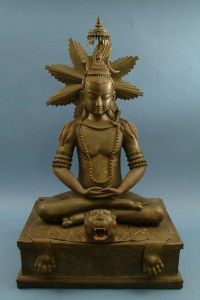A Season for Giving: 5 Diplomatic Gifts to the U.S. in the Smithsonian Collections
This holiday season, check out some of the most memorable diplomatic gifts given to U.S. presidents
/https://tf-cmsv2-smithsonianmag-media.s3.amazonaws.com/filer/20111223102005diplomatic-gifts2.jpg)
With the holiday season upon us, here’s a different sort of gift list: some of the most interesting, important and surprising diplomatic gifts given the U.S. over the past two centuries. The Natural History Museum‘s Department of Anthropology is home to hundreds of ceremonial items bestowed upon U.S. presidents and officials. Anthropologist Deborah Hull-Walski spoke with us about some of the most notable gifts in the collection.
1. Omani Cashmere Shawl: “The earliest presidential gifts in the Department of Anthropology were presented by the Sultan of Muskat and Oman, to President Martin Van Buren,” Hull-Walksi says. After Van Buren established the first U.S. consulate in an Arab Gulf State, the Sultan responded generously. Among his 1840 gifts were a number of luxurious cashmere shawls, some of the earliest diplomatic gifts held in the collection, along with pearls, carpet, perfumes and Arabian horses. Legend has it that he even presented several lions to honor America, which were briefly held at the American consulate.
2. Japanese Saddle: In 1858, Japan signed the Treaty of Commerce and Friendship with the U.S., its first treaty with any Western nation. As a result, in 1860, the Emperor sent a delegation to the U.S. for the first time, which came bearing gifts for President James Buchanan. The items included a traditional saddle, made of wood and leather, and embellished with gold lacquer and pearls. “The gifts given to President James Buchanan from the Emperor of Japan conveyed the hopes of continuing diplomatic relations between the Japanese and the American people,” says Hull-Walski.

3. Zuni Bear Claw Necklace: During an era of increased U.S. involvement overseas, Theodore Roosevelt received gifts from a number of countries, but one of the most unusual came from a sovereign American Indian nation: the Zuni people of New Mexico. Along with a prayer stick and ritual figurines was a necklace made out of the paws of a bear killed over 50 years earlier. “This item was given specifically to Roosevelt as a mark of high esteem for him as a great hunter of the cougar and bear,” Hull-Walski says.
4. Nepali Buddha Figurine: In 1945, after completing a round of postwar trade negotiations, President Harry Truman received a number of gifts from Nepal. His Highness the Maharaja Rana of Nepal said that the items were to help “remind him of far-off Nepal” in future years. This intricate Buddha sculpture, cast in brass, was among the items that Truman passed along to the Smithsonian Institution.
5. Hopi Kachina Doll: This doll, created by Hopi artist Joe Gash, was presented to then-Vice President George H. W. Bush in 1981. The Hopis create the cottonwood dolls as effigies to represent the ceremonial Kachina spirit. The doll is the most recent diplomatic gift to make it to the Smithsonian archives, as more recent gifts have been donated to Presidential libraries across the country.
/https://tf-cmsv2-smithsonianmag-media.s3.amazonaws.com/accounts/headshot/joseph-stromberg-240.jpg)
/https://tf-cmsv2-smithsonianmag-media.s3.amazonaws.com/accounts/headshot/joseph-stromberg-240.jpg)